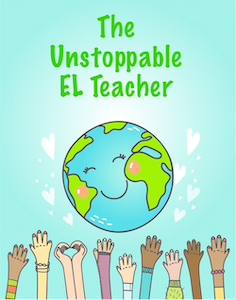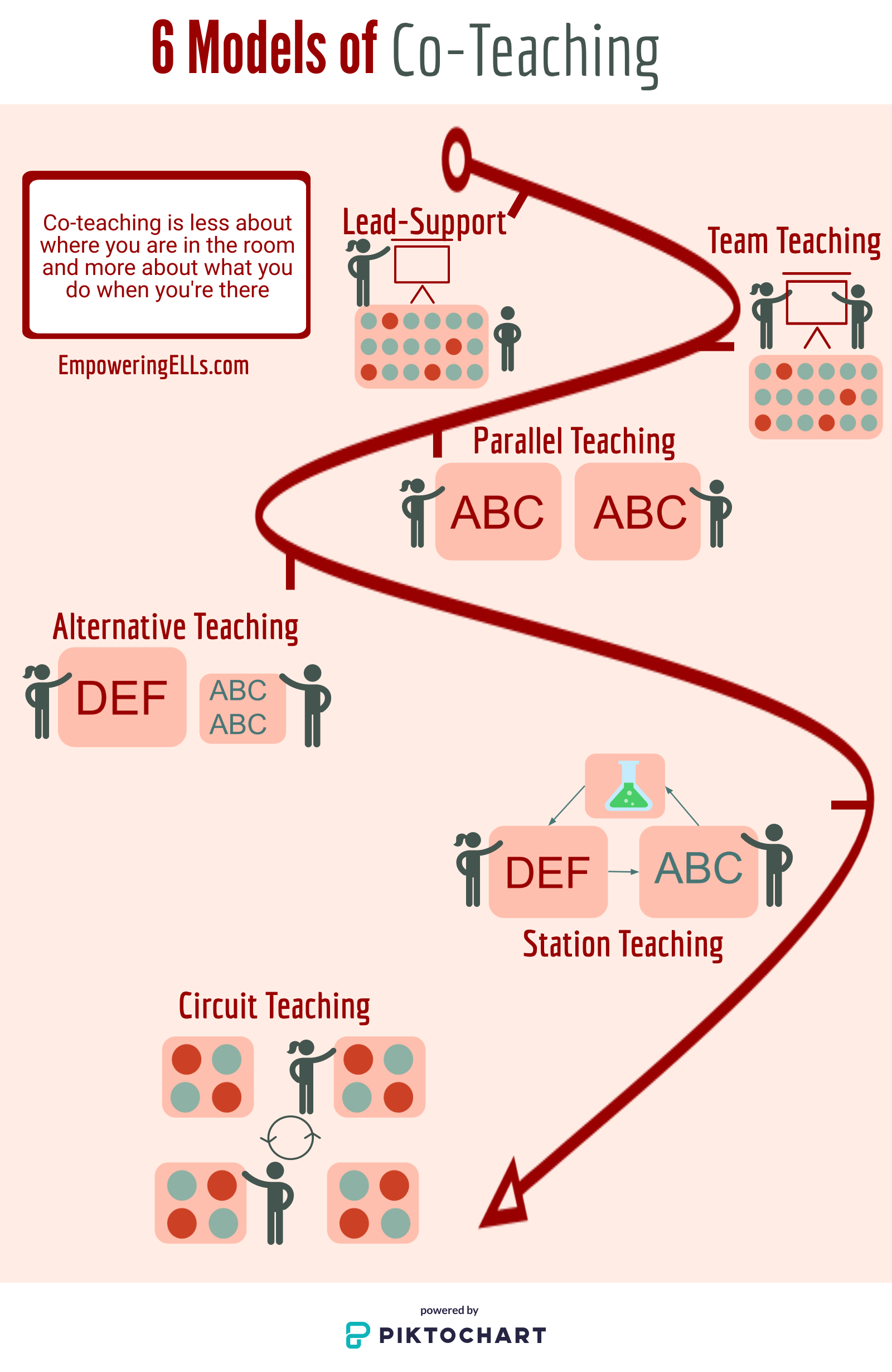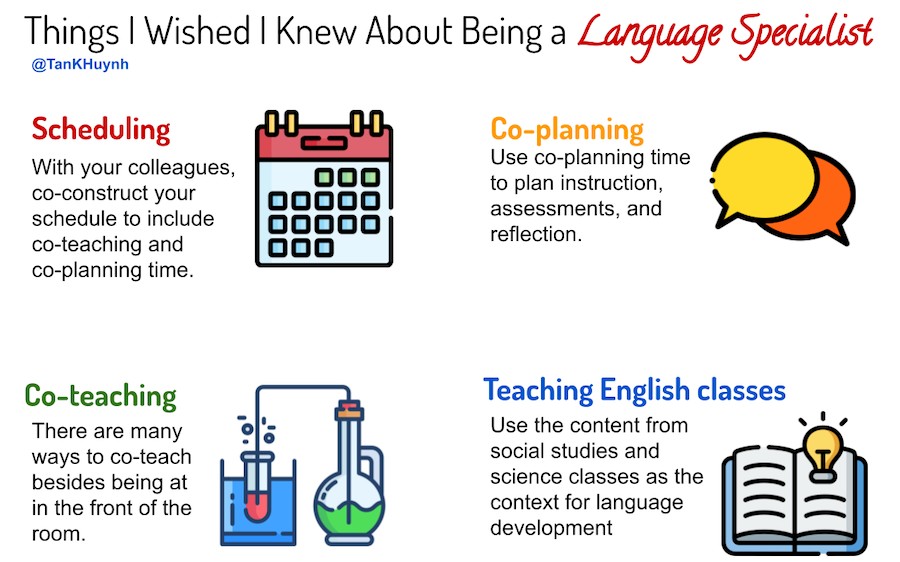What I Wish I’d Known about Co-Teaching LLs
A MiddleWeb Blog
 I have been a language specialist for eight years – six of those co-teaching with content teachers in middle and high school and two working with elementary teachers.
I have been a language specialist for eight years – six of those co-teaching with content teachers in middle and high school and two working with elementary teachers.
Yet I have never had a real orientation to learn my specific role, which – over these years – has included schedule making, co-planning, co-teaching, and running targeted classes for Language Learners.
I’ve had general school orientations when I begin my position, of course, but typically I’ve been left to figure the specifics out on my own – sink or swim. In the first years, I often sank before I could tread water.
Then, when I moved to the elementary school after a half dozen years at the secondary level, it felt like a completely new world, and I began learning my job – on the job – once again.
The fundamentals of being a language specialist
Looking back on all these experiences now, I realize my job has always had some similar, basic responsibilities – no matter the grade-level specifics.
The goal of this article is to provide you with an orientation that I never had. I will share with you what being a language specialist looks like at different levels and with various tasks. Even if you’ve been a language specialist for a while now, this still might be helpful to you if you’re moving between grade levels and divisions.
Scheduling
In both the elementary and high school levels, I received a beautiful schedule template… that was mostly blank. I was assigned a few language classes, but everything else was empty. No one had organized or directed me to coordinate or plan anything, so my first task was clear: to identify how many contact blocks full-time teachers had to have. A contact block refers to the time I am teaching students or the time I am co-planning with colleagues. My remaining time was reserved for personal planning time or admissions language placement testing.
Elementary scheduling
Since I worked as a member of a grade-level team, we co-constructed my schedule together. Each teacher would be given a set amount of my contact blocks during the 10-day cycle. The number changed based on how many language learners were in a particular class.
I made sure to ask that one of the allotted days in the 10-day cycle be given up to co-planning with each teacher individually. I also made sure to add the grade-level team meetings as one of my co-planning days, so I could plan with the entire team.
Does this sound challenging? If you’re new to being a language specialist, don’t be afraid to speak up for yourself. You will have much more success supporting the students you share responsibility for if you work closely with your colleagues.
Secondary scheduling
Each year I was assigned several grades to support. When I was assigned to work with grades 6, 7, and 8, my first priority was to provide sheltered instruction support in social studies and science in those grades. Initially, I asked to meet with the science and social studies teachers separately, but we found a better way.
When I met with the social studies teachers, we identified a period when they had common planning time as a department. I made that day one of my co-planning days because it would maximize my time by meeting with all the social studies teachers that taught grade 6 at the same time instead of individually meeting with each of them. We then identified the days when I could come and co-teach or offer in-class support. This set-up was repeated with the science department.
Scheduling tips
I recommend co-constructing the schedule with your colleagues instead of creating your schedule in isolation. This ensures that there will be planning time, and co-creating the schedule can also jump-start your all-important collaborative relationship.
Try not to have too many days pass in between your co-teaching and co-planning days because you will lose the flow of the collaboration. There is so much going on in a school, it’s easy to lose track of everything you need to do. Make collaboration a habit, and you’re more likely to stick to it.
Co-planning
This is where being in elementary school versus secondary school really makes a difference to this job. I co-planned very differently in elementary and secondary. In the elementary school, I doubled as a literacy coach, provided sheltered instruction, and co-taught to a large degree. However, in the secondary school, I offered strictly sheltered instruction support, so the co-planning changed accordingly.
Elementary co-planning
Because elementary school requires less content expertise (i.e., I didn’t have to teach balancing chemical equations in 5th grade), I was able to co-plan at the unit level where we looked at enduring understandings, essential questions, and the assessment. This helped as I grew to understand the unit from a bird’s eye level.
Not only that, we co-planned in ways that integrated social studies, science, and English. It was a multidisciplinary affair. My role was to scaffold the language, the lessons, and the assessments for all of these interdisciplinary units. Because I was able to co-teach the content in elementary school, I often co-planned the individual lessons with my co-teacher.
Secondary co-planning
Because I lacked the depth of understanding of middle and high school social studies content, my planning focused mainly on particular assessments, never the general unit level. I worked to co-format the assessments so they would not be reading tests but tests of content knowledge, building in scaffolds as needed.
For projects, though, we did co-plan on scaffolding the instructions and differentiating the tasks. At times, we also co-planned at the lesson level. I led a lesson on reading strategies, writing with academic language, or facilitating a debate to process a video or article.
Co-planning tips
Since co-planning leads to effective co-teaching, co-planning time is a must. When I first started, I didn’t realize the different things you can do during co-planning. You can co-assess and co-reflect as well (Honigsfeld & Maria, 2019).
Co-planning can also look different if you are more familiar with the particular content. Even if you do not have content-specific expertise, you can still be instrumental in co-planning assessments and projects. The goal of co-planning should be providing students with equitable access to challenging, grade-level content by improving teacher clarity (Fisher, Frey, & Hatie, 2016; Staehr Fenner & Snyder, 2017).
The more you can co-plan, the more you can possibly co-teach and make learning a more successful and equitable experience for language learners.
Lastly, because co-planning time is limited and scarce, make sure to plan the big-ticket items – such as assessments, projects, unit plans, and rubrics – instead of the small-ticket, one-time-use items, such as a graphic organizer, a bulletin board, or just tomorrow’s lesson.
Co-teaching
There was significantly more co-teaching in the elementary school as the content did not require a graduate degree of understanding in a specific discipline. However, co-teaching was still possible in secondary schools.

From Tan’s website, Empowering ELLs
Elementary co-teaching
Because we took the time to co-plan and because I did not require content expertise, I was able to co-teach many of the English, social studies, and even the science classes. When I taught, I usually started off teaching all the students before breaking into smaller groups.
Since my teachers and I co-planned the literacy lessons, I would teach the same lesson to the various homeroom classes. I also co-taught more consistently in the elementary school than at the secondary school as I assumed the literacy coach role for the grade.
Secondary co-teaching
Most of the time, I provided sheltered instructional support while students engaged in learning experiences. We used two models most often: circuit teaching and reinforce co-teaching.
Circuit teaching involved both me and the content teacher walking around to support all students. Reinforce co-teaching involved me providing small-group instruction to students as they worked to apply the content taught by the content teacher. At times, I had to reteach the lesson.
On very specific days, I would lead a whole-class mini-lesson usually related to literacy skills required to complete the assessment. The content expert always taught the content, and I supported students’ comprehension and application.
Co-teaching tips
I wish I had been told that co-teaching, like co-planning, is largely based on my familiarity with the content. Even though I co-taught more in the elementary school, there were still many ways to co-teach in secondary content classes even though I wasn’t an expert in the content.
Co-teaching isn’t just taking up space in the room; it’s the service we provide in that room. Therefore, co-teaching can mean working with small groups, circulating the room, or reinforcing a concept taught by the content teacher in addition to standing up at the front of the room.
Teaching English Classes
Collaborating with teachers encompasses much of my work, and I love it. The remaining time is devoted to teaching language learners who are enrolled in targeted English classes designed for language learners.
This looks the most similar across elementary and secondary levels. At both levels I used the content from social studies and science as the context to develop students’ literacy and language skills (Honigsfeld & Dove, 2019). This means that I planned thematically similar units but taught different aspects of the content. My literacy development class also served to make social studies and science content more comprehensible.
The elements of my targeted language classes consisted of:
- independent reading
- close reading of different genres
- co-constructing of different types of writing
- Tier 2 academic vocabulary
- grammar and mechanical awareness
We need to be fully integrated teachers
I knew my role as a language specialist would be different from my previous role as a literature teacher, but I did not realize that it would be so complex and nuanced. I didn’t realize how much collaborating I had to do with other teachers and that there were specific things I needed to do when collaborating, such as co-planning, co-teaching, co-assessing, and co-reflecting.
I thought my job was simply to show up and work with students in their content classes. Now I realize that our work as language specialists must be intentional and full of active planning and engagement with students and teachers alike.
I hope that these strategies help keep you afloat as you navigate your role while collaborating with others. In the comment section, please share what you wish you had learned about being a language specialist when you first started out.
You can listen to my podcast, “The roles of a language specialist,” here.
References
Fisher, D., Frey, N., & Hattie, J. (2016). Visible learning for literacy, grades K-12: Implementing the practices that work best to accelerate student learning. Thousand Oaks, CA: Corwin Literacy.
Honigsfeld, A., & Dove, M. G. (2019). Collaborating for English learners: A foundational guide to integrated practices. Thousand Oaks, CA: Corwin.
Staehr Fenner, D., & Snyder, S. (2017). Unlocking English Learners’ Potential: Strategies for Making Content Accessible. Thousand Oaks, CA: Corwin, a SAGE Company.


































